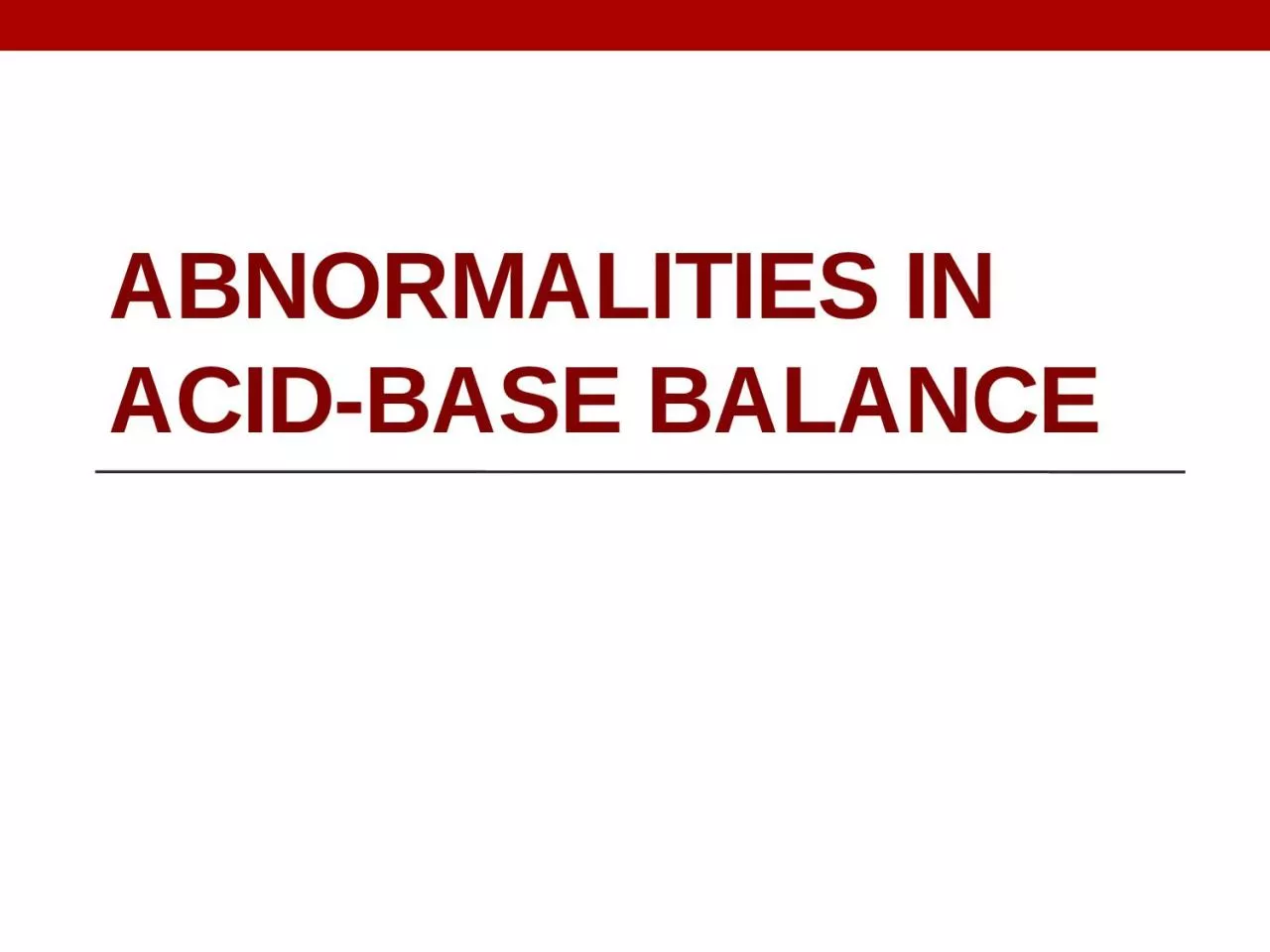

Many critical illnesses can disturb acidbase balance Acidbase disturbances may indicate an underlying disease or organ damage Accurate interpretation of acidbase disturbances requires the following ID: 1034111
Download Presentation The PPT/PDF document "Abnormalities in acid-base balance" is the property of its rightful owner. Permission is granted to download and print the materials on this web site for personal, non-commercial use only, and to display it on your personal computer provided you do not modify the materials and that you retain all copyright notices contained in the materials. By downloading content from our website, you accept the terms of this agreement.
1. Abnormalities in acid-base balance
2. Many critical illnesses can disturb acid-base balance.Acid-base disturbances may indicate an underlying disease or organ damage.Accurate interpretation of acid-base disturbances requires the following: Arterial blood gases. Plasma electrolytes. Knowledge of the compensatory physiologic mechanisms.Abnormalities in Acid-Base Balance(Appel & Downs. 2008. Understanding acid-base balance)
3. Abnormalities in Acid-Base Balance
4. Abnormalities in Acid-Base BalanceAcidosisAlkalosis ↑↑ PCO2Respiratory↓↓ HCO3-Metabolic↓↓ PCO2Respiratory↑↑ HCO3-Metabolic
5. Acid-base disorders are classified by changes in pH, PCO2 and HCO3-There are 4 primary acid-base disorders: Respiratory acidosis: ↑ PCO2 Respiratory alkalosis: ↓ PCO2 Metabolic acidosis: ↓ [HCO3-] Metabolic alkalosis: ↑ [HCO3-]The body normally attempts to correct the primary acid-base disturbances by a secondary or compensatory response trying to restore pH towards normal. The kidneys compensate for primary respiratory disorders. The lungs compensate for primary metabolic disorders.Fundamentals in Acid-Base Disorders(Dooley & Sisson. Acid-base disorders)
6. Primary Acid-Base DisturbancesDecreased ventilationInhibition of respiratory centerLung damageAirway obstructionCOPDIncreased ventilationPsychoneurosisHigh altitudeMechanical overventilationPregnancyLoss of HCO3- or gain of H+Renal tubular acidosisDiarrheaDiabetesIngestion of acids (alcohol or aspirin)Ch. renal failureExcess HCO3- or loss of H+Diuretics except CAIHyperaldosteronismVomiting gastric contentsIngestion of antacids
7. Respiratory acidosis = ↓ pH + ↑ PCO2 Due to alveolar hypoventilation.Respiratory Acidosis
8. Respiratory alkalosis = ↑ pH + ↓ PCO2 Due to alveolar hyperventilation.Respiratory Alkalosis
9. Metabolic alkalosis = ↑ pH +↑ [HCO3-]Due to loss of acids.Due to gain of HCO3-Metabolic Alkalosis(Appel & Downs. 2008. Understanding acid-base balance; Dooley & Sisson. Acid-base disorders)
10. Metabolic acidosis = ↓pH due to ↓ [HCO3-] Due to acid gain. Due to loss of HCO3Metabolic Acidosis(Appel & Downs. 2008. Understanding acid-base balance; Dooley & Sisson. Acid-base disorders)
11.
12.
13. Primary DisturbanceCompensatory MechanismRespiratory Acidosis Increase HCO3Respiratory AlkalosisDecrease HCO3Metabolic AcidosisDecrease PCO2Metabolic AlkalosisIncrease PCO2Compensatory Mechanisms
14. Summary of Primary Acid-Base Disorders
15. Interpretation of Acid-Base DisturbancesNormal values;pH =7.35-7.45PCO2 =35-45 mmHgHCO3-= 22-28 mmol/L
16. pHPCO2 (mmHg)HCO3 (mEq/L)Normal7.35-7.4535-4522-28Respiratory acidosisDecreaseIncreaseIncreaseRespiratory alkalosisIncreaseDecreaseDecreaseMetabolic acidosisDecreaseDecreaseDecreaseMetabolic alkalosisIncreaseIncreaseIncreaseSimple Acid-Base Disturbances
17. A patient known to have COPD presented with 3-day history of fever, SOB, and cough productive of yellowish sputum. His ABGs showed:pH = 7.25PCO2 = 80 mmHg.[HCO3-] = 34 mEq/L.Case study 1
18. A 21 year old man with IDDM presents to ER with mental status changes, nausea, vomiting, abdominal pain and rapid respirations. His ABGs showed:pH = 7.2PCO2 = 20 mmHg[HCO3-] = 8 mEq/lCase study 2
19. A 2-year old child who is lethargic and dehydrated has a 3-day history of vomiting. His ABGs showed:pH = 7.56PCO2 = 44 mmHg[HCO3-] = 37 mEq/l Case study 3
20. A 20-year old student suffered a panic attack while awaiting an exam. Her ABGs showed:pH = 7.6PCO2 = 24 mmHg.[HCO3-] = 23 mEq/L. Case study 4
21. Simple acid-base disordersResult from a single primary abnormality with appropriate physiologic compensation.Mixed acid-base disordersResult from multiple primary processes.Other Acid-Base Disorders
22. Mixed Acid-Base DisturbancesOccurs when a patient has more than one primary acid base disorder that occur at the same time.Examples: Respiratory alkalosis/acidosis along with a metabolic acidosis/alkalosis. Two metabolic acid-base disorders occurring simultaneously.
23. A 69 year old patient known to have COPD presented with a 3-day history of abdominal pain and diarrhea. His ABGs showed;pH = 6.96PCO2 = 55mmHg [HCO3-] = 12 mmol/L Case study 5
24. Thank you
25. Body’s Response to Acidosis
26. Body’s Response to Alkalosis